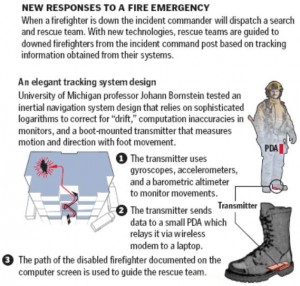
Inertial tracking systems have an unfortunate tendency to slowly drift over time. University of Michigan Professor Johann Borenstein has developed a very effective solution to that problem. First, he places a MEMS sensor in a boot. With every step, the sensor is momentarily stationary, allowing drift to be completely reset. According to Prof. Borenstein:
…during the brief moment of being stationary (i.e., the boot having zero velocities) we can compare that known condition with the velocities computed from the accelerometer data. This allows us not only to estimate the accelerometer drift with great accuracy, but also to remove that drift from the next step (and, in part, retroactively from the previous step). This way our accelerometer drift is fully “reset” with every step. The result is that we can estimate distance traveled with an accuracy of 1% of distance traveled for unlimited walks. The ability to reset accelerometer drift with every step and thus roughly once every second is unique to walking. Designers of missiles and submarines would kill for that benefit…
Borenstein developed a patent-pending Heuristic Drift Elimination (HDE) algorithm to eliminate effects of MEMS gyros’ sensitivity to linear acceleration and drift. He reports his system has average heading errors near zero in walks of unlimited duration and average position error <1% of distance traveled in walks of less than 30 minutes.
In a simulated rescue exercise held at the Worcester Polytechnic Institute’s campus, Borenstein’s system helped the Worcester Fire Department found a “lost” firefighter in just under ten minutes – compared to an unassisted rescue time of twenty four minutes. [Full disclosure – my company Q-Track, also participated in the exercise. Further details in the links below]. The Boston Globe’s Hiawatha Bray wrote an excellent description of the exercise, including the graphic of Borenstein’s system (above).
Unfortunately, Borenstein has had difficulty finding a commercialization partner for the technology. See: Personal Tracking System Touted as Lifesaver for First Responders (National Defense Magazine) for details.
Previously on ÆtherCzar:
- NFER® FLARE Firefighter Rescue Video Now Available: a detailed account of the performance of Q-Track’s system in the 2010 WPI PPL workshop simulated rescue exercise,
- 5th WPI PPL Workshop Proceedings Online: an update with a link to the conference proceedings,
- Q-Track’s Tracking System Prototype Successful in Trial: coverage from the Huntsville Times,
- Q-Track’s Firefighter Location System Succeeds in Trial: the “day-after” report on the firefighter rescue trials including photos, and
- Precision Indoor Personnel Location and Tracking: background information on the WPI PPL Workshop.
Additional information and a report on the WPI PPL Workshop are available from the TRX Blog, here.
Update (12/8/2010): Deleted: “In typical walking, the boot will be stationary more than half the time, enabling any inertial drift during that period to be ignored.” The explanation above has been corrected. Thanks to Prof. Borenstein for pointing out the error. For additional information, including a video of the system, see: http://www.engin.umich.edu/research/mrl/00MoRob_23.html.
